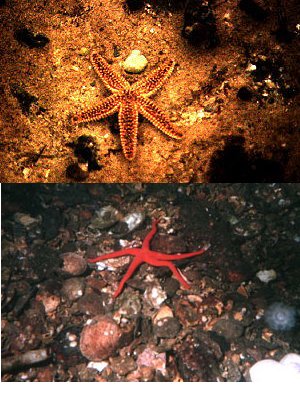
The two animals to the left are probably the best known from this phylum. They are the Sea star, (upper half) with the blood star (lower half). Though the Brittle Star (bottom left) is also related to them. Make sure not to confuse these three animals as for they may sometimes look alike.
For instance did you know that the Sea Star can regenerate, or grow back up to four of its arms? Or did you know that they have light sensitive eye spots at the end of each one of their arms? Now are you ready to find out how they eat? Sea Stars pull open bivalve shells, evert their stomachs inside and digest their prey inside its own shell!
You can find this star-shaped echinoderm in middle intertidal to subtidal zones. Look for it to have numerous rounded spines on top and four rows of tube feet below.
Wounder
how they use those tube feet?? Now you can see a Movie of How
Sea Stars Move!
(may take a while to load)
The Blood Star (lower half of top picture) may sometimes look like the Sea Star, but in reallity is fairly different. These animals have narrow arms with fine, red grannular surfaces. A spot on the upper side of the star, the madreporite (mestaicanly called the "eye") actually allows water to pass into the animals body, this is necessary to maintain shape. Also unlike the Sea Star Blood Stars feed almost entierly on sponges. To find this Echinoderm look in lower intertidal and subtidal zones. It should have a light yellow underside and two rows of tube feet.
Above you can see (hopefully) a Sea Cucumber and A Daisy Brittle Star (to the left) . These are two very interesting animals. The Sea Cucumber is unique in the fact that to get away from prey it will throw up its guts, and grow them back later! The Brittle Star is special for many reasons. This snake-like moving animal is surprizingly fragille, and easilly broken off. Residing in lower intertidal areas this star will mainly stay around sponges, matted growth and holdfast of seaweed. Also able to regenerate these secretive, but quick moving echinoderms will mostly scavenge minute particles, worms and small crustaceans.
